
|
 |

|
 |
The ballet Bayadere - 'Temple Dancer' - a favourite among ballet-goers since 1877 - Rajika Puri e-mail: rajikapuri@yahoo.com November 30, 2018 Ever since its premiere in St Petersburg in 1877, the ballet La Bayadere has fascinated audiences not just in Russia but around the world. The master choreographer, Marius Petipa (whose bicentenary is celebrated this year) himself oversaw three different versions during his lifetime, the last in 1900 when he was 82 years old. This genius, considered the father of 'classical ballet', not only created over 50 of them but his versions of many classics, like the ballet Giselle that he revived, are regarded as definitive. Some of the most popular ballets seen today from Sydney to San Francisco: Swan Lake, Sleeping Beauty, Don Quixote, are associated with him and one of his most enduring creations is La Bayadere, a fantasy tale about an Indian temple dancer, devadasi, a being who fascinated the European world for centuries. Ever since Marco Polo, European voyagers to India had enthusiastically described beautiful young women they saw dancing in the temples of India with grace, delicacy and a total devotion to their deity. The French word bayadere - derived from the Portuguese bailadeira, 'female dancer', and first used by a 16th c trader - fired the European imagination, especially after they read Goethe's 1797 poem, Der Gott und die Bajadere ('The god and the Bayadere').The very first western ballet on the theme with the same title in French, Le Dieu et la Bayadere was choreographed for Marie Taglioni by her father Filippo, and known in England as The Maid of Cashmere. 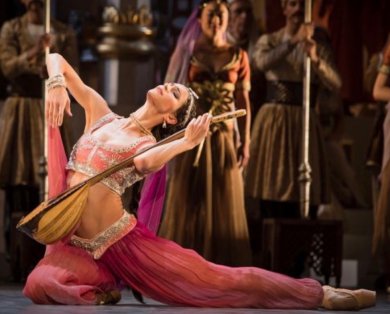 Polina Semionova as Nikiya with vina in Berlin Bayadere Photo: Yan Revazov 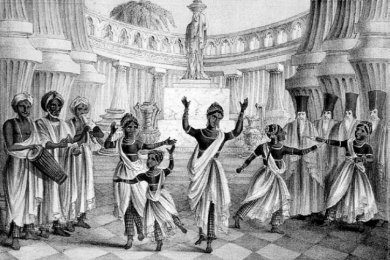 4 devadasis, a child and musicians in 1838 on European tour Not until 1838, however, did Europeans get a chance to see a troupe of actual temple dancers who toured France, England, Germany, Austria and Belgium causing quite a sensation and feeding an extant thirst for Indian-influenced music and dance: Tilammal (aged 30), Ammani (18), Rangam (14) and Sundaram (13) from Tiruvendipuram, near Pondicherry in Tamilnadu, accompanied by their nattuvanar Ramalingam Mudali, and two musicians who played the mattalam and a drone pipe known as titti. The sensation they caused though was less due to their performances than to lurid stories about their being courtesans - even prostitutes - with which the press had a field day. Still, soon after they left, in 1839 Johann Strauss Sr wrote the very popular dance music called Der Indianer-Galopp in 1858, Lucien Petipa choreographed the ballet Sacountala based on Kalidas' play and, in 1877, his brother Marius premiered his La Bayadere in St Petersburg 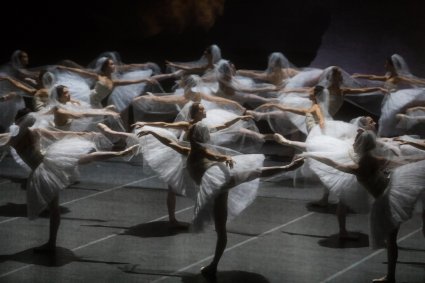 The 32 Shades enter one by one 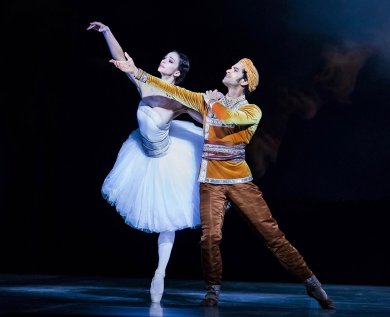 Polina Semionova as the 'shade' of Nikiya & Alejandro Virelles as her beloved Solor, in the Kingdom of the Shades The project started with an extensive libretto, co-written with the dramatist Sergei Khudekov, which demonstrates a knowledge of Sanskrit and of India: the temple procession of Act I is described as including "munis, rsi, bramacarins and, finally, gurus in long linen garments." It continues, however, to say, "The priests wear [pendants made of] cords on their foreheads - a sign of brahminesque rank"! Yet the very next line is "From the pagoda also emerge devadasi (bayadères of the first rank)." And throughout the story there are elements that in fact reflect the life of a devadasi, who in those days would often be connected to both temple and court. Thus, the fact that the heroine, Nikiya, dances at the engagement celebrations of her rival the princess Gamzatti (Hamasatti in the original libretto) rings true. So too her dance with a vina reflects an understanding of her being both dancer and musician. The story: Nikiya is in love with a kshatriya, Solor, and after a little persuasion agrees to run away with him, but only after he takes a vow in front of the sacred temple fire that his heart will remain true to her his whole life. (During research for the program notes I was asked to write for the Staatsoper-Berlin brochure, I read of a Scotsman who had stolen away with a devadasi, though, of course, she thereby gave up her sacred status). The lovers are, alas, overheard, by the High Brahmin, himself in love with Nikiya, who visits Raja Dugmanta to tell him of Solor's plan to elope with the devadasi, not knowing that the latter had just virtually commanded Solor to marry his beautiful daughter Hamsatti. So, instead of punishing Solor, Dugmanta decides that Nikiya must die! He orders Ayah to place a serpent in the basket of flowers she will dance with the next day - and, sure enough, at the end of her dance she is bitten - and dies, bereft at her beloved's perfidy. 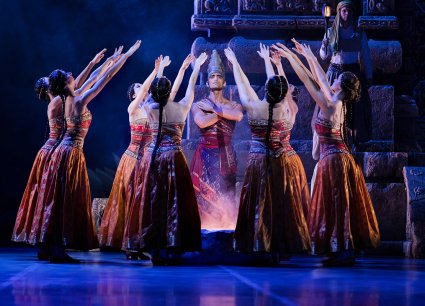 High Brahmin Vahe Martirosyan and Bayaderes  Yolanda Correa as Gamzatti being betrothed by Tomaso Renda as Raja Dugmanta to Alejandro Virelles as Solor The next act has the most well-known scene from this ballet, set in the Kingdom of the Shades to which Solor is lured by Nikiya's ghost who visits him while he sleeps. We see thirty-two 'shades' or spirits, dressed all in white, enter one by one, each repeating a simple move: one step forward followed by an arabesque with back leg extended parallel to the ground, until the stage slowly fills with these heavenly creatures. Here Nikiya can be with Solor and, of course dance with him again. Most 20th c versions of the ballet - and there have been a plethora of them - end with the wedding of the kshattriya and his princess, an opportunity to finally include some spectacular divertissements or spectacular 'pure' dances. One version of the ballet, in 1948, even added a Shiva like figure covered in gold, whose dance thereafter became another highlight of this ballet: The Bronze Idol. Most versions only have three acts and leave out the original finale in which, at the very moment Solor and Hamsatti are married, the gods - angry at the egregious breaking of a sacred vow made in the temple itself - create an earthquake. To the accompaniment of thunder and lightning the temple collapses and buries the Raja, his daughter and the High Brahmin as it collapses. When the air clears, we see Nikiya glide into the far distance over the Himalayas, with Solor, lovingly, at her feet. 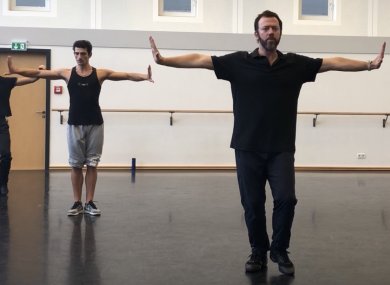 Alexei Ratmansky teaching gesture for 'everyone leave' to Vahe Martirosyan as High Brahmin 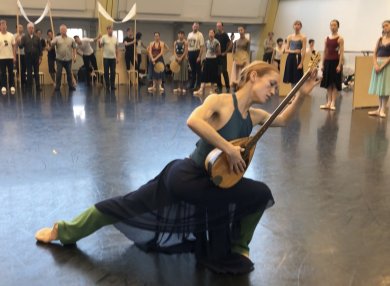 Ksenia Ovsyanick as Nikiya rehearsing the 'vina dance' Photos: Rajika Puri These changes caused Alexei Ratmansky, the most in-demand ballet choreographer today, who is also devoted to reconstructing Marius Petipa's masterpieces like The Sleeping Beauty and Swan Lake, to take on the task of bringing to life Petipa's 1900 version of La Bayadere. Commissioned by the Staatsballet-Berlin, he studied Petipa's extensive notes, and archival material that not only included old lithographs and photos but also extensive notation in the Stepanov system. In Petipa's time, much of a ballet's story was told through a large vocabulary of ballet mime and Mr. Ratmansky, a lover of classical Indian dance, who has often been a guest at the Dancing the Gods festival I co-curate with the World Music Institute in New York, asked if I could help figure out some gestures that were missing in the notation. We had fun trying to develop gestures that might on the one hand be universal but also fit in with a ballet vocabulary. I noticed that apart from a hand position that was neutral, somewhat like a relaxed hand, they also use what looks like pataka, a soft alapadma (such as is used to ask "why?" or "what?"), as also mushti, two of which crossed at the wrists in a downward movement signify 'die' or 'death'. I was, however, surprised when I suggested we use a soft shikhara for 'warrior", to show a sword being put back in its scabbard that Mr. Ratmansky said he now recalled that Petipa had used that gesture in one of his other ballets. Most of all I was taken aback, when after performing some of these gestures for him, and infusing each with the emotional intent of the character - as we do in our abhinaya - Mr. Ratmansky turned to me and said, "If the Staats ballet agreed to invite you to come coach the dancers in mime, could you come - even for a short while?". Of course, in spite of a horrendous work-load ahead of me (three slide lectures in Mumbai and Bangalore early December, plus viewing of lots of dance and film for the two nominations committees I serve in this year), I immediately responded with a delighted "YES!" Thus, it was that I was able to learn a lot about how ballet mime is supposed to work as I watched this master-choreographer dance every single step as he taught it to the four sets of principal dancers who would alternate the soloist roles in this production: Nikiya, Solor, Gamzatti (as she is called now), Rajah Dugmanta, the High Brahmin, Fakir Mahadevaya, and Ayah. Hearing of this, Rukmini Vijaykumar, who has studied ballet, asked me to change the title of the talk I was to give in Bengalaru and, instead, do a presentation of the Bayadere itself. Given that I had extensive photographic and video footage of the process, including some even in costume taken at the last dress-rehearsal on November 3 this year, I gladly accepted the commission. The slide/video presentation is just about ready, and though the mime demonstrations have yet to be sequenced, there are, already, other 'takers'. Hema Rajagopalan asked me to present it to her Natya Dance Theater dancers and students in early February and I hope to do it in Mumbai next year. 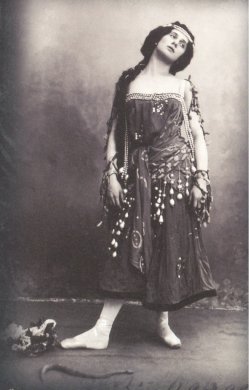 Anna Pavlova as Nikiya in 1932 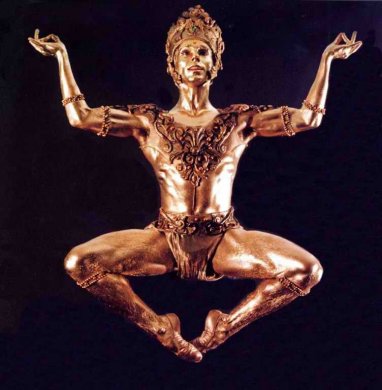 Bronze god dance-Ranka Bayadere Alexei, you really started something! I, who disliked the way gestures were performed for his reconstruction of the Golden Cockerel but then fell in love with the way Nicoletta Manni performed them as the Swan Queen Odette, in the finale of his Swan Lake reconstruction for Milan's La Scala ballet, am now being complimented on the way the dancers did the mime for this Berlin Bayadere. However, I have to admit that, actually, it's Alexei who deserves most of the credit. He is a genius and I was lucky to have been 'a fly on the wall' as he - and his lovely wife and helpmate Tatiana - put together a stellar production that at one point has almost a 100 dancers and extras on stage - all in a relatively short number of rehearsal days. Video excerpts on line: vimeo.com/173238936 Finale of Ratmansky's Swan Lake for the Scala youtu.be/WFkWLvqJjWw Polina Semionova in excerpts from the Berlin Bayadere Rajika Puri is an exponent of two forms of Indian classical dance - Bharatanatyam and Odissi - as well as lecturer, writer, and co-curator of several Indian dance festivals in New York. Her current specialtiesare a form of danced-storytelling (in which she sings, chants, and narrates in English as she dances stories from myth) and slide lectures accompanied by demonstration. Post your comments Please provide your name and email id when you use the Anonymous profile in the blog to post a comment. All appropriate comments posted with name & email id in the blog will also be featured in the site. |